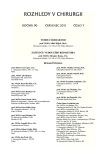Surgical Management of Perforations during Colonoscopy
Authors:
J. Dostalík; P. Guňková; L. Martínek
; I. Guňka; P. Klvaňa 1; M. Mazur; P. Ziman 2
Authors‘ workplace:
Chirurgická klinika FN Ostrava, přednosta: doc. MUDr. J. Dostalík, CSc.
; Gastroenterologické oddělení, Interní klinika FN Ostrava, přednosta: doc. MUDr. A. Martínek, CSc.
1; Chirurgická ambulance Lékařský dům, Šumperk
2
Published in:
Rozhl. Chir., 2011, roč. 90, č. 7, s. 389-392.
Category:
Monothematic special - Original
Overview
Introduction:
Colonoscopy is an effective both diagnostic and therapeutic method. Despite its wide use, however, colonoscopy may be associated with complications occurrence, of which the most serious is bleeding and perforation. Iatrogenic perforation can lead to the peritonitis with high morbidity and mortality. The relative frequency of perforation in diagnostic colonoscopies is 0.03–0.8%, for therapeutic colonoscopy 0.15–3%. The most iatrogenic perforations are located on sigmoid colon.
Patients and Methods:
The endoscopic unit of University Hospital Ostrava performed a total of 7800 colonoscopy in the period between 1st January 2006 to 31st December 2010. In 8 patients (0.1%) occurred perforation of the colorectum. In all patients, this complication arose during diagnostic colonoscopy and was treated by surgery. Six patients (75%) were operated on within 24 hours from the performance of colonoscopy, 2 patients (25%) were operated after more than 24 hours. In 5 patients (62.5%) the left colon including rectum was perforated, in 3 patients (37.5%) perforation occurred in right colon.
Results:
Postoperative complications occurred in 7 patients, postoperative morbidity was 87.5%. In 1 patient (12.5%) surgical revision was necessary. 2 patients died within 30 days after surgery, mortality was 25%.
Conclusion:
Iatrogenic perforation of the colorectum is one of the most serious complications during colonoscopy. Early and optimal treatment is crucial for the subsequent reduction of serious complications and mortality.
Key words:
colonoscopy – bowel injury
Sources
1. Wolff, W. I., Shinya, H. Colonofiberoscopy. JAMA, 217 (1971), 1509–1512.
2. Lüning, T. H., Keemers-Gels, M. E., Barendregt, W. B., Tan, A. C., Rosman, C. Colonoscopic perforations: a review of 30,366 patients. Surg. Endosc., 21 (2007): 994–997.
3. Bleier, J. I., Moon, V., Feingold, D., Whelan, R. L., Arnell, T., Sonoda, T., Milsom, J. W., Lee, S. W. Initial repair of iatrogenic colon perforation using laparoscopic methods. Surg. Endosc., 22 (2008): 646–649.
4. Dítě, P. Akutní stavy v gastroenterologii. Galén, (2005), ISBN 80-7262-305-2, s. 253–260
5. Hansen, A. J., Tessier, D. J., Anderson, M. L., Schlinkert, R. T. Laparoscopic repair of colonoscopic perforations: indications and guidelines. J. Gastrointest. Surg., 11 (2007): 655–659.
6. Mai, Ch. M., Wen, Ch., Wen, S. H., Hsu, K. F., Wu, Ch., Jao, S. W., Hsiao, Ch. W. Iatrogenic colonic perforation by colonoscopy: a fatal complication for patients with a high anesthetic risk. Int. J. Colorectal Dis., 25 (2010): 449–454.
7. Rotholtz, N. A., Laporte, M., Lencinas, S., Bun, M., Canelas, A., Mezzadri, N. Laparoscopic approach to colonic perforation due to colonoscopy. World J. Surg., 34 (2010): 1949–1953.
8. Jentchura, D., Raute, M., Winter, J., Henkel, T., Kraus, M., Manegold, B. C. Complications in endoscopy of the lower gastrointestinal tract: therapy and prognosis. Surg. Endosc., 8 (1994): 672–676.
9. Yang, D. H., Byeon, J. S., Lee, K. H., Yoon, S. M., Kim, K. J., Ye, B. D., Myung, S. J., Yang, S. K., Kim, J. H. Is endoscopic closure with clips effective for both diagnostic and therapeutic colonoscopy – associated bowel perforation? Surg. Endosc., 24 (2010): 1177–1185.
10. Iqbal, C. W., Shin Chun, Y., Farley, D. R. Colonoscopic perforations: a retrospective review. J. Gastrointest. Surg., 9 (2005): 1229–1236.
11. Saunders, B. P., Fukumoto, M., Halligan, S., Obling, C., Moussa, M. E., Bartram, C. I., Wiliams, C. B. Why is colonoscopy more difficult in women? Gastrointest. Endosc., 43 (1996): 124–126.
12. Cappello, M., Randazzo, C., Peralta, S., Cocorullo, G. Subcutaneous emphysema, pneumomediastinum and pneumoperitoneum after diagnostic colonoscopy for ulcerative colitis: a rare but possible complication in patient with multiple risk factors. Int. J. Colorectal. Dis., 2010, DOI 10.1007/s00384-010-1005-7.
13. Hall, C., Dorricott, N. J., Donovan, I. A., Neoptolemos, J. P. Colon perforation during colonoscopy: surgical versus conservative management. Br. J. Surg., 78 (1991): 542–544.
14. Kavin, H., Sinicrope, F., Esker, A. H. Management of perforation of the colon at colonoscopy. Am. J. Gastroenterol., 87 (1992): 161–167.
15. Šerclová, Z., Antoš, F. Taktika řešení kolonoskopických perforací. Rozhl. Chir., 11 (1999): 578–582.
16. Trecca, A., Gaj, F., Garliardi, G. Our experience with endoscopic repair of large colonoscopic perforations and review of literature. Tech. Coloproctol., 12 (2008): 315–322.
17. Wullstein, C., Koppen, M., Gross, E. Laparoscopic treatment of colonic perforations related to colonoscopy. Surg. Endosc., 13 (1999): 484–487.
18. Valez, M. A., Riff, D. S., Mule, J. M. Laparoscopic repair of a colonoscopic perforation. Surg. Endosc., 11 (1997): 387–389.
19. Martínek, L., Vávra, P., Anděl, P., Mazur, M. Laparoskopické řešení iatrogenní léze kolon při koloskopii. Rozhl. Chir., 11 (2004): 559–561.
Labels
Surgery Orthopaedics Trauma surgeryArticle was published in
Perspectives in Surgery

2011 Issue 7
- Metamizole vs. Tramadol in Postoperative Analgesia
- Metamizole at a Glance and in Practice – Effective Non-Opioid Analgesic for All Ages
- Current Insights into the Antispasmodic and Analgesic Effects of Metamizole on the Gastrointestinal Tract
Most read in this issue
- Antibiotic Prophylaxis in Acute Surgical Procedures – The Current Praxis in Czech Republic
- Arthritis Sternoclavicularis as a Cause of Mediastinitis
- Surgical Management of Perforations during Colonoscopy
- 750 Satisfied Patients? Stapled Haemorrhoidopexy (Longo Procedure) for the Treatment of Haemorrhoids and Anal Canal Prolapse: A Review of our 10-year Experience
